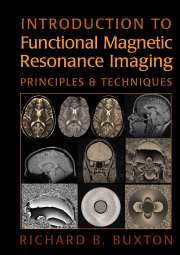5 - Magnetic Resonance Imaging
from IB - Introduction to Functional Magnetic Resonance Imaging
Published online by Cambridge University Press: 05 September 2013
Summary
PRINCIPLES OF MAGNETIC RESONANCE IMAGING
In Chapter 4 we discussed how the local magnetic resonance (MR) signal is produced as a result of the interaction of the particular pulse sequence parameters with local tissue properties. The pulse sequence produces a transient pattern of transverse magnetization across the brain. How do we map that pattern? It is remarkable that magnetic resonance imaging (MRI) is able to image the distribution of transverse magnetization in the human brain with a spatial resolution of better than 1 mm, even though the coils used for generating the RF pulses and detecting the signal are much larger. The heart of MRI can be stated in a beautifully simple way: the phase of the local signal is manipulated in such a way that the net signal traces out the spatial Fourier transform of the distribution of transverse magnetization. A full interpretation of what this statement means is developed in Chapter 10, but the basic concepts involved in making an MR image are described here.
RF Coils
In an MRI scanner the radiofrequency (RF) coil used to detect the MR signal is sensitive to a large volume of tissue. For example, in brain imaging studies the subject is placed in a cylindrical coil that surrounds the head, and typically this coil is used both for the transmit and receive parts of the experiment. When one of the simple pulse sequences described earlier is applied, the entire head will be exposed to the RF pulses, and the resulting signal produced in the coil will be the sum of the signals from each tissue element in the head.
Information
- Type
- Chapter
- Information
- Introduction to Functional Magnetic Resonance ImagingPrinciples and Techniques, pp. 86 - 103Publisher: Cambridge University PressPrint publication year: 2002
